Archive Record
Images
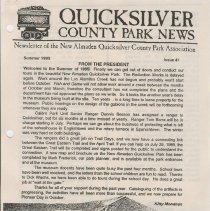
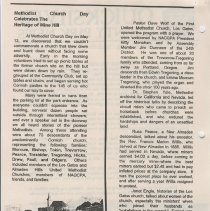
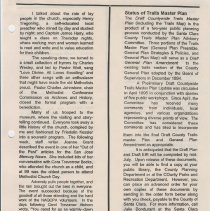
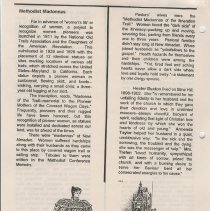
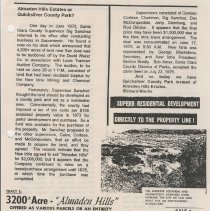

Additional Images [8]
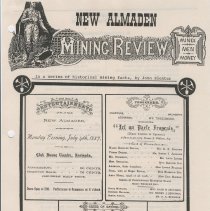


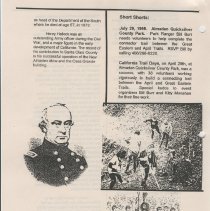

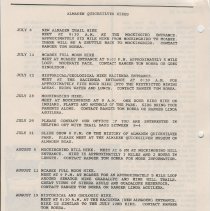
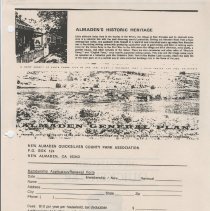
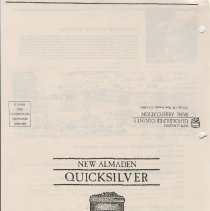
Metadata
Catalog number |
1997.2.2613 |
Object Name |
Newsletter |
Date |
1995 |
Description |
TITLE: Quicksilver County Park News SUBTITLE: Newsletter of the New Almaden Quicksilver County Park Association Issue # 41 Summer 1995 Newsletter of the New AImaden Quicksilver County Park Association Summer 1995 Issue 41 FROM THE PRESIDENT Welcome to the Summer of 19951 Finally we can get out of doors and conduct our tours in the beautiful New Almaden Quicksilver Park. The Reduction Works is delayed again. Work around the Los Alamitos Creek has not begun and probably won't start before October. Fish and Game will not allow work around a creek between the months of October and March; therefore the consultant has not completed the plans and the department has not approved the plans as we write. So it looks like another years delay in the museum being built at the site. Ten years is a long time to lease property for the museum. Public hearings on the design of the gabions in the creek will be forthcoming whenever they are ready. Calero Park Unit Senior Ranger Dennis Besson has assigned a ranger to Quicksilver, but for six months at a time instead of yearly. Ranger Tom Berra will be in charge starting in July. Perhaps we can go about the business of protecting what is left of the schoolhouse in Englishtown and the rotary furnace in Spanishtown. The winter was very hard on both buildings. The rangers did a great job on Trail Days, and we now have a connecting link between the Great Eastern Trail and the April Trail. If you can help on July 29, 1995, the Great Eastern Trail will be completed and signs posted for the public to understand the connection. A new map and brochure on the New Almaden Quicksilver Park has been completed by Mark Frederick, our park planner, and is available at the park entrances and at the museum. The museum docents have been quite busy the past four months. School tours have been well received, and the letters from the school children are fun to read. Thanks to Dick Wachs, we have been able to do tours during the school day. He does a great job at "wait at the gate." Thanks for all of your support during the past year. Cataloguing of the artifacts is progressing, the activities have all been more than successful, and we now prepare for Pioneer Day in October. Kitty Monahan Methodist Church Day Celebrates The Heritage of Mine Hill At Methodist Church Day on May 13, we discovered that we couldn't commemorate a church that blew down and burnt down without facing some adversity. Early in the morning volunteers tried to set up picnic tables at the former church site on the hill but were driven down by rain. They regrouped at the Community Club, set up tables and chairs, and began serving hot Cornish pasties to the 145 of us who found our way to cover. Many were ferried in vans from the parking lot at the park entrance. As everyone couldn't squeeze into the building, serveral dozen people sat outside through intermittent showers; and over a speaker set in the doorway we all heard stories of the pioneer Methodists. Among those attending were about 70 descendants of the predominantly Cornish church, representing the following families: Morcum, Bishop, Tokin, Trevorrow, Pearce, Tresidder, Tregoning, Hicks, Drew, Faull, and Odgers. Others included members of the Los Gatos and Almaden Hills United Methodist Churches, members of NAQCPA, friends, and families. Pastor Dave Wolf of the First United Methodist Church, Los Gatos, opened the program with a prayer. We were welcomed by NACQPA President Kitty Monahan and by Assembly Member Jim Dunneen of the 24th District. He was one of about 20 members of the Trevorrow-Tregoning family who attended, coming from as far away as Portland, Oregon. Jim descends from Edwin Tregoning, a class leader in the church, and Emma Morcum Tregoning, who played the organ and directed the choir 100 years ago. Dr. Stephen Yale, Methodist archivist for California and Nevada, led off the historical talks by describing the circuit riders who came to preach on horseback before churches were established, and who endured the hardships and dangers of an unsettled land. Russ Pearce, a New Almaden descendant, talked about his ancestor, the Rev. Francis Marion Willis, who served at New Almaden in 1885. Willis had served in Nevada, where miners earned $4.00 a day, before coming to the mercury mine-where the best miners earned but $2.48 and had to pay inflated prices at the company store. It was the poorest place he ever worked, and after serving a year Willis resigned in protest. Janet Engle, historian of the Los Gatos church, talked about women of the church, especially the ministers' wives who joined their husbands as "yokefellows to the gospel." Typical was Mrs. Trefren who lived on Mine Hill from 1866-68 and who "loved humanity, sympathized with all kinds of sorrow, prized the church:" I talked about the role of lay people in the church, especially Henry Tregoning, a self-educated local preacher who mined by day and studied by night; and Captain James Harry, who taught a class on Thursday nights, where working men and women learned to read and write and to value education for their children. The speaking done, we turned to a small collection of hymns by Charles Wesley, and led by Pastor Wolf, sang "Love Divine, All Loves Excelling" and three other songs with an enthusiasm that might have made the old Methodists proud. Pastor Charles Johnstone, chair of the Methodist Conference Commission on Archives and History, closed the formal program with a benediction. Many of us trooped to the museum, where the visiting and story-telling continued. Everyone took away a little history of the church, compiled by me and fashioned by Friedolin Kessler into a souvenir program. The following week, staff writer Joanne Grant described the event in one of her "Out of the Past" articles for the San Jose Mercury News. She included bits of her conversation with Cora Trevarrow Bocks, who attended the church as a child, and at 99 was the oldest person to attend Methodist Church Day. Adversity pulls people together, and the rain brought out the best in everyone. The event succeeded because of the goodwill of all those attending and the hard work of the NAQCPA volunteers. In the days following Carol Trevarrow Alstrom wrote, "You cared for us so warmly-down to the homemade cookies Mary Frederick, 92, who was born on the hill and ate her pasty in the rain with husband Ted, called it a wonderful event. Gage McKinney Status of Trails Master Man The Draft Countywide Trails Master Plan (including the Trails Map) is the product of a two-year public planning process conducted by the Santa Clam County Trails Master Plan Advisory Committee. Three portions of the Trails Master Plan (General Plan Preamble, General Plan Strategies & Policies, and General Plan Map) will serve as a Draft General Plan Amendment to the existing trails section of the County General Plan adopted by the Board of Supervisors in December 1994. A Preliminary Draft Countywide Trails Master Plan Update was circulated in April 1995 in conjunction with a series of five public workshops. Since April, the Committee has received many comments from individuals, local agencies, and various organizations representing diverse points of view. The Committee has considered these comments and has tried to incorporate them into the final Draft County Trails master Plan and General Plan Amendment as appropriate. It is anticipated that the Draft Plan and Draft EIR will be completed by mid-July. Upon release of these documents, you will be able to find a copy at your public library, the County Planning Department or at the COunty Parks and Recreation Department. However, you can place an advanced order for your own copies of these documents by sending in the order form below along with you check, payable to the County of Santa Clara. For more information, call Julie Bondurant at the Santa Clara County Parks 8 Recreation Department at 408/35&3741, extension 152. Methodist Madonnas Far in advance of "women's lib' or recognition of women, a project to recognize women pioneers was launched in 1911 by the National Old Trails Association and the Daughters of the American Revolution. This culminated in 1928 and 1929 with the placement of 12 identical statues on sites marking locations of various old trails, which stretched across the United States--Maryland to California. Each statue depicts a pioneer woman in sunbonnet, flowing skirt, and boots--walking, carrying a small child, a three-year old tugging at her skirt. The inscription, reads, "Madonna of the Trail-memorial to the Pioneer Mothers of the Covered Wagon Days." Frequently, pioneers and their rugged life have been honored, but this recognition of pioneer women, as statues were installed and dedicated across our land, was far ahead of the times. There were "madonnas" at New Almaden. Women suffered hardships along with their husbands as they came to this place by covered wagon trail or sailing ship. Tributes to them were written in the Methodist Conference Memoirs. Pastors' wives were the "Methodist Madonnas of the Itineration Trail." Women faced the "dark side' of the itineracy-packing up and moving, severing ties, parting from fiends every one to three years. Pastoral families didn't stay long at New Almaden. Wives joined husbands as "yokefellows to the gospel." Health hazards for themselves and their children were among the hardships. "Yet, tired feet and aching hearts never allow a dark side where love and loyalty hold sway."--a statement by one clergy spouse. Hester Buxton lived on Mine Hill, 1898-1902. She "is remembered for her unfailing fidelity to her husband and the work of the church to which they gave their devotion and love in unstinted measure--always cheerful, buoyant of spirit, radiating that light of Christian love and kindness by which she won the hearts of old and young." Armenda Taylor helped her husband in a quiet, unobtrusive way: "to the sick and the sorrowing, the troubled and the dying, she was the messenger of help." Mrs. Trefen "loved humanity, sympathized with all kinds of sorrow, prized the church, and with a burning desire to serve her Saviour bent all her consecrated energies to his cause." Almaden Hills Estates or Quicksilver County Park? One day in June 1973. Santa Clara County Supervisor Sig Sanchez returned to his office after conducting business in Sacramento. He found a note on his desk which announced that 4,200+ acres of land near San Jose was to be auctioned off by the David Weisz Go. in association with Louis Traiman Auction Company. The auction, to be held on June 26 at 1 P.M., consisted of land that had been declared surplus by the New Idria Mining and Chemical Company. Fortunately, Supervisor Sanchez thought the land should be developed as a county park and not as a residential area. Coincidentally, the county had imposed a tax of ten cents per $100 assessed property value in 1972 for parks' development and purchase. So a fund was available for the purchase of the property. Mr. Sanchez proposed to the other supervisors, Calvo, Cortese, and McCorquodale, that an effort be made to acquire the land, and they agreed. The records indicate that the New Idria agreed to sell "Almaden Hills" for $2,000,000; but it appears that the Company continued to mine on a lease/purchase arrangement until 1975, at which time the purchase was completed. TRACT 1: 3200tAcre - "Almaden -Hills" OFFERED AS VARIOUS PARCELS OR AN ENTIRETY One o the Fastest growing Cities in the U.S.A ADJOINING SAN JOSE IN BURGEONING SANTA CLARA COUNTY Also TRACTS 2 8 3 Total 1000' Acres-Separate and upon from 3200`Ac.;.Almaden Hills"Tract Supervisors consisted of Dominic Cortese, Chairman, Sig Sanchez, Dan McCorquodale, Jerry Steinberg, and Rod Diridon. It appears that the final price may have been $1,500,000 due to the New Idria lease arrangement. The deal was consummated on June 17, 1975, at 9:30 A.M. New Idria was represented by George Blackstone, Secretary, and New Idria President, Benton Bradly. Bob Amyx, Santa Clara County Director of Parks, accepted the claim deed on July 22, 1975. And so today we have Quicksilver County Park instead of Almaden Hills Estates. Richard Wachs THE SUPERIOR LOCATION AND MAGNIFICENT SIGHTINGS OVER-LOOKING THE CITY OF SAN JOSE MAKE THIS AN OUTSTANDING ACQUISITION SALE On TUESDAY, JUNE 26 at 1 P.M., DST Songs of Summer Signs of summer have been long in coming this year, but some have finally appeared. Not all are showy like the bright late spring flowers that herald the arrival of warm temperatures, but some are obvious in other ways. If you look closely at the trunks of some of the oaks or other large trees in the park, you may see some strange apparitions hanging there. Looking like dried-up corpses, the cast skins of cicada nymphs represent many years of reclusive growth culminating in a one month last fling for an often heard but seldom seen insect. Cicadas are Homopterans, a group of insects that includes aphids, plant hoppers, whiteflies, and scale insects--a rogue's gallery of plant pests that suck the life out of plants. Cicadas are our largest Homopterans and the many species vary in size from slightly less than an inch to two inches in length. Cicadas are singers-and they sing loudly. At times the countryside rings with their high-pitched wailing. We may not appreciate the din, but of course it isn't meant for us. Each species has its own song, and its purpose is to attract a mate. Adult cicadas sing for sex for about a month and then they die-unless a bird or wasp or some other predator shortens their swan song even more. Female cicadas deposit their eggs in the twigs of trees and shrubs-an activity which usually kills the twigs. The eggs hatch in about a month, and the little nymphs drop to the ground and burrow down to feed on roots. This phase of the life cycle is not short. These little root-suckers usually spend 13 to 17 years underground before they emerge to embark on their short-lived singing career. Its no wonder they sing so well--they've had a long time to memorize the tune. They leave the ground by the thousands when their time has come. After shedding their skin for the last time, they fly off to give voice to the forest. Usually their song is so powerful it is virtually impossible to pinpoint the source. Frequently called t7-year locusts, although unrelated to real locusts, their songs are as much a part of summer as are the melodic songs of birds. Bob Clement Volunteer Program Has New Office The Santa Clara County Parks Volunteer Program now has a new home! It is called The Office of Interpretive and Volunteer Services and is located in the old concession building at Vasona Lake County Park in Los Gates. The building interior has been attractively remodeled and houses Chris Crockett Parks Volunteer Coordinator, Robin Schaut, Interpretive Program Coordinator, and Rianne, Program Assistant for Interpretive & Volunteer Services. The office is open for business Monday through Friday, from 8 A.M. to 4:30 P.M. The general office number is 408/354-4902, and the Volunteer Program number is 408/354-8583. Next time you're at Vasona, drop on by and say, "Hi!" NEW ALMADEN In a series of historical mining Henry Wager Halleck and the New Almaden Mine R. Lawrence Comstock Henry Halleck is best known for his service in the American Civil War as a Major General who, in June of 1862, was appointed General-in-Chief of the Union Army. During his tenure as General-in-Chief the major battles fought were Antietam, Chancellorsville, Gettysburg and Vicksburg. He was replaced in 1864 as General-in-Chief by the newly appointed Lieutenant General Ulysses Grant, and Halleck became Chief-of-Staff of the Army reporting to Grant, serving in that position until the end of the war. What is not so well known about Henry Halleck is that he was the first Director General of the New Almaden quicksilver, or mercury, mine from 1852 to 1861. During this period he led the development of the mine from a primitive to a relatively modem operation. How did Halleck achieve this important appointment in the first mine in California? To answer this question we must briefly outline his personal history. Early years of Henry Halleck Halleck was tom in 1815 in Oneida County, New York, of mixed German and English ancestry. He worked on his fathers farm and attended Union College until his appointment to the United States Military Academy at West Point in 1835. He graduated third in the Class of 1839. Some of his contemporaries at West Point who gained fame during the Civil War were Ulysses Grant, William Sherman and James Longstreet. Halleck joined the prestigious Corps of Engineers and worked on coast and harbor defenses. At age thirty he authored the book "Elements of Military Arts and Sciences" (1846), which was a text at West Point and was studied by many officers in the Union Army and later by Abraham Lincoln. With the outbreak of the Mexican-American War, Halleck was assigned to California, where he designed the fortifications for Monterey and for the Presidio in San Francisco. He was on the expedition to Baja California which captured that province for the United States. For his personal bravery Halleck was promoted to Captain. Baja was not included in the possessions of the United States in the final settlement with Mexico. Returning to California after the end of the war, Halleck became Secretary of State to the military governor, Governor Mason. As a delegate to the Constitutional Convention in Monterey, Halleck helped establish the civil government for California by writing much of the state constitution. During this period he wrote " A Collection of Mining Laws of Spain and Mexico", a book widely read by people interested in acquiring mines in the new state. During the interval between the end of the Mexican-American War and Calrfomia's statehood, the mining laws in effect in California were those of Mexico. On the basis of his knowledge of mining law, Halleck was admitted to practice law in California. He formed the law firm of Peachy, Halleck and Billings, and this firm was hired by the British fine of . Barron and Fortes to represent the New Almaden Mining Company, which controlled the mercury mines at New Almaden. The title to the mine was contested by the Quicksilver Mining Company and by the United States Government, which believed the original claim of Andreas Castillero, on which the New Almaden Company was based, was fraudulent. The Quicksilver Mining Company was a Wall Street firm which owned title to lands adjacent to the New Almaden property and on which mercury mining was also conducted. The New Almaden Company owners were impressed with Halleck and asked him to accept the position as Director General at a salary of $500 per month Henry Halleck and the New Almaden Mines When Halleck was appointed to his position with the New Almaden Company, the quicksilver mine was a primitive operation, profitable because of the high grade of the ore. In 1852 treated cinnabar (MgS) ore was 25% mercury. This was high enough so that recovery could be done with the simple technology of heating whalers pots containing the ore and recovering the mercury by condensation in water underneath the pats. This process was both inefficient and dangerous. Under Halleck's leadership, new furnaces were designed which improved the percentage of recovery and, equally important, reduced the emissions of mercury gas and noxious sulfur dioxide(S02). Six brick-lined furnaces, with ducts to pass the poisonous gases away from the valley floor, sustained the production until major improvements were made by the Quicksilver Mining Company, to whom the mine was sold in 1863. During Halleck's period of leadership, the average yearly income from the mine was 1.5 million dollars. In 1854, to have a suitable place to stay in New Almaden when he visited the mine,Halleck built the Casa Grande. The building was also motivated by his wife, Elizabeth,who was the granddaughter of Alexander Hamitton.The Casa Grande, which has three stories and twenty seven rooms, was built in the Federal style then popular in California. The two-foot thick brick walls have withstood all major earthquakes including the Loma Prieta quake. Halleck also had built at this time the Montgomery Block in San Francisco, then the largest building in the West which lasted until after the Second World War. Halleck's other connection to the New AImaden Mine, besides his position as Director General, was through his law firm. Title to the mine had been under attack since the early days.The litigation was between the New Almaden Company, the Quicksilver Mining Company and the U.S. Government. The litigation was held in lower courts in Santa Clara County and later in the Supreme Court The title of the New Almaden Company was upheld until 1863 when the United States Supreme Court ruled that the title was fraudulent. By this time Halleck was deep in the management of the Union Army during the Civil War, and was not involved in the litigation of his law firm, from which he had resigned. However, he did object to the attempted seizure of the mine by the Lincoln Administration in July 1863, by strongly advising the president not to involve the government in a private property dispute. The New Almaden Company sold its interest to the Quicksilver Mining Company, an American firm, in 1863, which made the U.S. authorities more comfortable. Henry Halleck returned to California after the Civil War as the Commander of the Department of the Pacific; however, he apparently had lost his entrepreneurial spirit and stayed in the army. A statue of him is in Golden Gate Park and a street near his Montgomery Block bears his name. He was transferred to Louisville Kentucky as head of the Department of the South where he died at age 57, in 1872. Henry Halleck was an outstanding Army officer during the Civil War, and a major figure in the early development of California. The record of his contribution to Santa Clara County is his successful operation of the New Almaden Mine and the Casa Grande building. Henry Halleck in Civil War uniform. Huntington Library Short Shorts: July 29, 1995. Almaden Quicksilver County Park. Park Ranger Bill Burr needs volunteers to help complete the connector trail between the Great Eastern and April Trails. RSVP Bill by calling 4081268-8220. California Trail Days, on April 29th, at Almaden Quicksilver County Park, was a success, with 38 volunteers working vigorously to build a connecting trail between the April and Great Eastern Trails. Special kudos to event organizers Bill Burr and Kitty Monahan for their fine work. Flood of '55 Rain, rain, and more rain! Everything soggy, drippy, and noisy. The creek in back of my house, Los Alamitos Creek, separated my house from Connie (Kambish) Perham's New Almaden Museum. My four children and I had just moved in a few months earlier and assumed the rising creek was an annual event. We had been preparing for the Christmas season by baking cookies and other goodies. Around eight P.M., two or three days before Christmas, I began to be concerned about three young children whose parents had left them at home and the youngest, just an infant, with me while they shopped. Since I had the five youngsters with me and no car, I decided to call the county sheriff to check on the other children because their house was built right on the creek bank. The rain had been steadily falling for around nine days, with debris having washed down from the Almaden Reservoir. Two officers arrived to assess my situation and left to check on the children down the creek. They soon returned with a report that their patrol car had been afloat. Reversing their direction to the south of my house, they discovered that the water was well over the road and again they were afloat. Reporting back to their lieutenant, who arrived by slogging through a newly formed creek in the middle of the road [Bertram Road was now Bertram Creek or, rather, River.], the two officers quickly came to attention after enjoying a holiday cheered up by a cup of coffee. We later learned the bridge at the north end of Bertram had washed out. Somehow Tom Fortini brought his big flatbed truck around and towed one car after another to higher ground. My children and I were in a friend's car which was next to last to be towed out. The last two cars met near disaster when Tom's truck turned over in the raging stream, about a hundred feet or so south of what is now the Community Center. We were all very grateful when we arrived at Cafe Del Rio, where friends and family were instructed to pick us up and house us for a few days. After thirty-nine years, that is the clearest of my recollections. Mary (Lindemann) Foster Docent at Forbes Mill Museum ALMADEN QUICKSILVER HIKES JULY 8 NEW ALMADEN TRAIL HIKE MEET AT 8:30 A.M. AT THE MOCKINGIRD ENTRANCE. APPROXIMATELY SIX MILE HIKE FROM MOCKINGBIRD TO MCABEE. THERE WILL BE A SHUTTLE BACK TO MOCKINGBIRD. CONTACT RANGER TOM BORRA. JULY 14 MCABEE FULL MOON HIKE MEET AT MCABEE ENTRANCE AT 9: CO P.M. APPROXIMATELY 5 MILE LOOP. MODERATE PACE. CONTACT RANGER TOM BORRA OR GREG BINGLESON. JULY 22 HISTORICAL/GEOLOGICAL HIKE HACIENDA ENTRANCE. MEET AT THE HACIENDA ENT-~ANCE AT 8:30 A.M. FOR APPROXIMATELY FIVE HOUR HIKE =NTO THE RESTRICTED MINING AREAS. BRING WATER AND LUNCH. CONTACT RANGER TOM BORRA. JULY 28 MOCKINGBIRD HIKE. MEET AT MOCKINGBIRD AT 9 A.?!. ONE HOUR KIDS HIKE ON INDIANS, PLANTS AND ANIMALS O: THE PARK. KIDS BRING YOUR PARENTS ALONG. CONTACT RANGE=R TOM BORRA OR RANGER LINDA AGUILERA. JULY 29 PLEASE CONTACT OUR OFFICE _F YOU ARE INTERESTED IN HELPING OUT WITH TRAIL DAYS BETWEEN 9-4 JULY 31 SLIDE SHOW 8 P.M. ON THE HISTORY OF ALMADEN QUICKSILVER PARK. PLEASE MEET AT THE ALM-ADEN QUICKSILVER MUSEUM ON ALMADEN ROAD. AUGUST 5 MOCKINGBIRD HILL HIKE. MEET AT 6 PM AT MOCKINGBIRD HILL ENTRANCE. HIKE IS APPROXIMATELY 3 MILES AND 2 HOURS IN LENGTH. CONTACT RANGER TOM BORRA FOR MORE INFORMATION. AUGUST 11 MCABEE FULL MOON HIKE. MEET AT 9 P.M. AT MCABEE FOR AN APPROXIMATELY 5 MILE LOOP AROUND SENATOR MINE GUADALL?E AND MINE HILL TRAILS. GREAT VIEWS OF SIERRA AZULE AND GUADALUPE RESERVOIR. CONTACT RANGER TOM BORRA OR RANGER LINDA AGUILERA. AUGUST 19 HISTORICAL AND GEOLOGIC HIKE. MEET AT 8:30 A.M. AT THE HACIEKDA (NEW ALMADEN) ENTRANCE. HIKE IS SIMILAR TO THE JULY 22ND HIKE. CONTACT RANGER TOM BORRA. AUGUST 25 SLIDE SHOW 8 P.M. ON THE HISTORY OF ALMADEN QUICKSILVER PARK. MEET AT THE ALMADEN QUICKSILVER MUSEUM. FOR MORE INFORMATION PLEASE CALL 268-3633 Almaden's Historic Heritage Little different today than in the heyday of the 49ers, the village of New Almaden and its adjacent mine area is a valuable link with the past deserving careful protection. Driving out Almaden Road from a busy metropolitan valley, one suddenly finds himself in a world of over hundred years ago when New Almaden was a flourishing mining community producing quicksilver used in gold mining and later in making explosives for the Union Army in the Civil War. In the hills above the village are brick chimneys, mine shafts, a powder house, and other remains of the mines. There are also cemeteries and other relics of Mexican Camp and English Town once heavily populated mining camps. This area and the village below could be operated as a historical park like Columbia State Park in the Mother Lode country, where the daily life of the town goes on in a normal way in state-protected buildings rich in the flavor of the past. A joint County of Santa Clara and City of San Jose Study November 1963. |
People |
Alstrom, Carol Trevorrow Besson, Dennis Borra, Tom Burr, Bill Buxton, Hester Clement, Bob Comstock, Larry Fortini, Tom Foster, Mary Lindemann Frederick, Mark Frederick, Mary (Mary Trevorrow Frederick) Frederick, Ted Halleck, Henry (Wager, Sr., Jr.) McKinney, Gage Monahan, Kitty Morcum, Thomas H. Pearce, Russell Trefren, J. L. (Reverend) Tregoning, Edwin T. Tregoning, Emma Morcom Tregoning, Henry Trevarrow, Cora (Bocks) Wachs, Richard Willis, Francis Marion (Rev.) |
Cataloged by |
Meyer, Bob |
